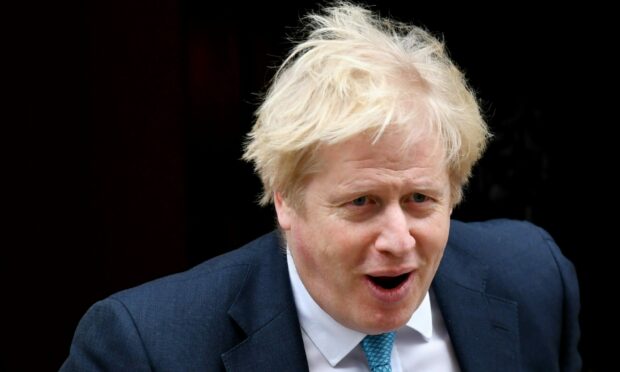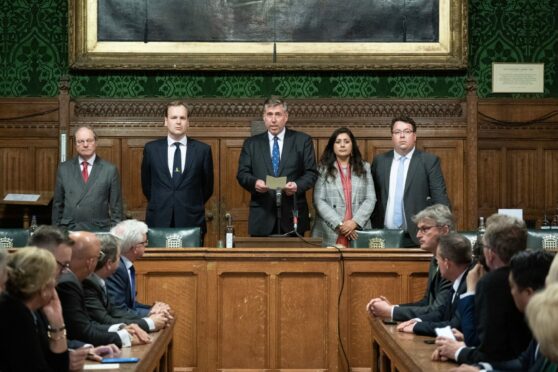Boris Johnson has survived a confidence vote in his leadership of the Tory party but his authority has been dealt a significant blow.
Tory MPs voted by 211 to 148 in support of the Prime Minister but the scale of the revolt against his leadership leaves him wounded.
When Theresa May faced a confidence vote in 2018 she secured the support of 63% of her MPs – but was still forced out within six months.
Mr Johnson saw 41% of his MPs vote against him, a worse result than Mrs May.
The Prime Minister made a last-ditch plea to Tory MPs to back him, promising future tax cuts and highlighting his own record of electoral success.
But with concern over the partygate scandal, economic policy, drifting opinion polls and Mr Johnson’s style of leadership, the Prime Minister faced a difficult task to persuade his doubters.
The ballot was triggered after at least 54 MPs – 15% of the party’s representatives in the Commons – said they had no confidence in the Prime Minister.
‘I understand the anxieties of people who have triggered this vote’
Mr Johnson wrote to Tory MPs and addressed them at a private meeting in Westminster in the hours before voting began.
He told the meeting that “under my leadership” the party had won its biggest electoral victory in 40 years, and pledged future tax cuts, with Chancellor Rishi Sunak expected to say more in the coming weeks.
Having listened closely to people in Moray who re-elected me and people across Scotland, tonight I will support the motion of no confidence in the Prime Minister. pic.twitter.com/YXE0rEyvsn
— Douglas Ross MP MSP (@Douglas4Moray) June 6, 2022
He warned them that Tory splits risked the “utter disaster” of Sir Keir Starmer’s Labour entering Downing Street, propped up by the SNP.
“The only way we will let that happen is if we were so foolish as to descend into some pointless fratricidal debate about the future of our party,” he said.
He told Tory MPs “I understand the anxieties of people who have triggered this vote” but “I humbly submit to you that this is not the moment for a leisurely and entirely unforced domestic political drama and months and months of vacillation from the UK”.
In an attempt to win round low-tax Tories, Mr Johnson said: “The way out now is to drive supply-side reform on Conservative principles and to cut taxes.”
The Prime Minister was informed on Sunday afternoon that he would face the vote after Sir Graham Brady, the chairman of the backbench 1922 Committee, confirmed he had received the letters from Conservative MPs needed to trigger the ballot on Sunday.
A steady stream of Tory MPs called publicly for the Prime Minister to stand down in the wake of Sue Gray’s report into breaches of the Covid regulations in No 10 and Whitehall.
Party lost confidence over partygate
But Tory concerns go far wider, covering the Prime Minister’s policies, which have seen the tax burden reach the highest in 70 years, and concerns about his style of politics.
Mr Johnson received the resignation of his anti-corruption tsar, John Penrose, who said the Prime Minister had breached the ministerial code over the partygate scandal and should quit.
Scottish Tory leader Douglas Ross said he would be voting against Mr Johnson, having heard “loud and clear the anger at the breaking of Covid rules”.
Ex-foreign secretary Jeremy Hunt, who stood against Mr Johnson for the leadership in 2019, warned that the Tories would lose the next general election if the Prime Minister is allowed to remain in post.
“Having been trusted with power, Conservative MPs know in our hearts we are not giving the British people the leadership they deserve,” he said.
Former minister Jesse Norman, who had been a long-standing supporter of Mr Johnson, published a scathing letter to the Prime Minister, saying the Gray report showed Mr Johnson “presided over a culture of casual law-breaking at 10 Downing Street”.
But his criticism of Mr Johnson was far broader, including the “ugly” policy of sending migrants on a one-way trip to Rwanda, the “unnecessary and provocative” privatisation of Channel 4, the ban on noisy protests which “no genuinely Conservative government” should have introduced, and the lack of a “sense of mission” in his administration.
Scottish politicians react
SNP Westminster Leader Ian Blackford MP has slammed the result, claiming Mr Johnson has “lost the confidence of the public”.
“Tory MPs should have drawn a line under Boris Johnson’s disastrous time as Prime Minister but instead they’ve bottled it – allowing this damaging circus to continue and leaving the Westminster government in crisis.
“The UK is now stuck in limbo with a lame-duck Prime Minister who has lost the confidence of the public – and more than forty percent of his own MPs – and is left limping around on borrowed time while the Tory party descends into bitter division.”
He added: “As for Douglas Ross, his position is completely untenable. If he had any principles or dignity he should quit as Scottish Tory leader. He has made himself look utterly ridiculous by flip-flopping over Boris Johnson’s future and will have no authority or credibility if he tries to cling on.”
Secretary of State for Scotland Alister Jack has exclaimed Mr Johnson still has his support.
He said: “As I have been clear throughout, the Prime Minister has my full support. I voted for him tonight, and I am very pleased that he has received the backing of a clear majority of the Parliamentary party. We now need to put this behind us, and get on with what really matters – tackling the very real major challenges we face both at home and abroad.”

